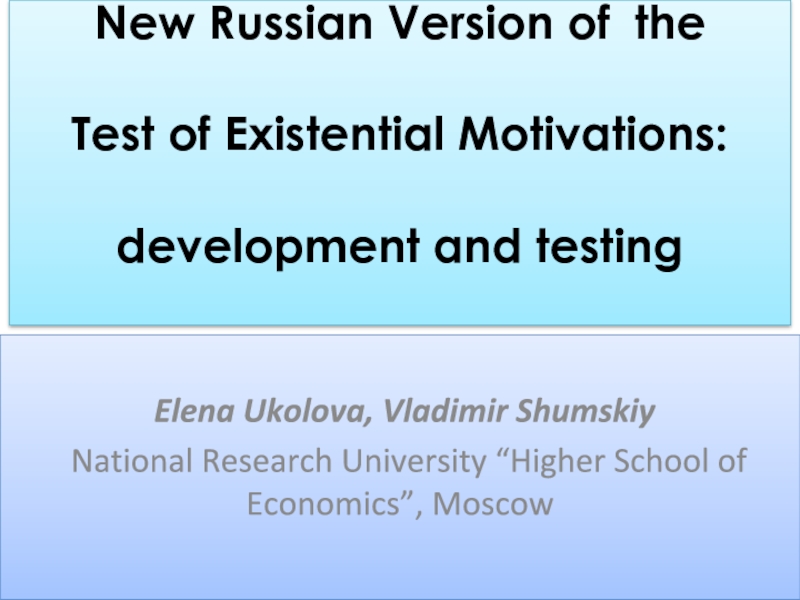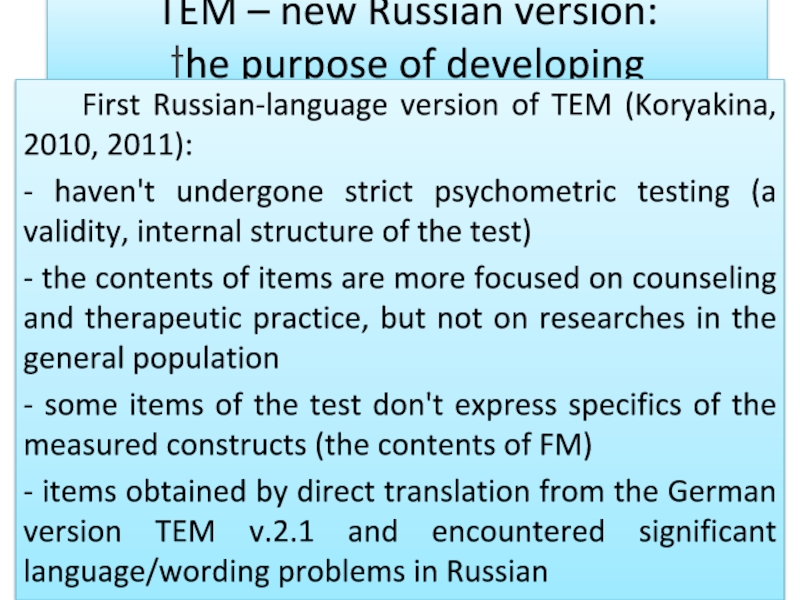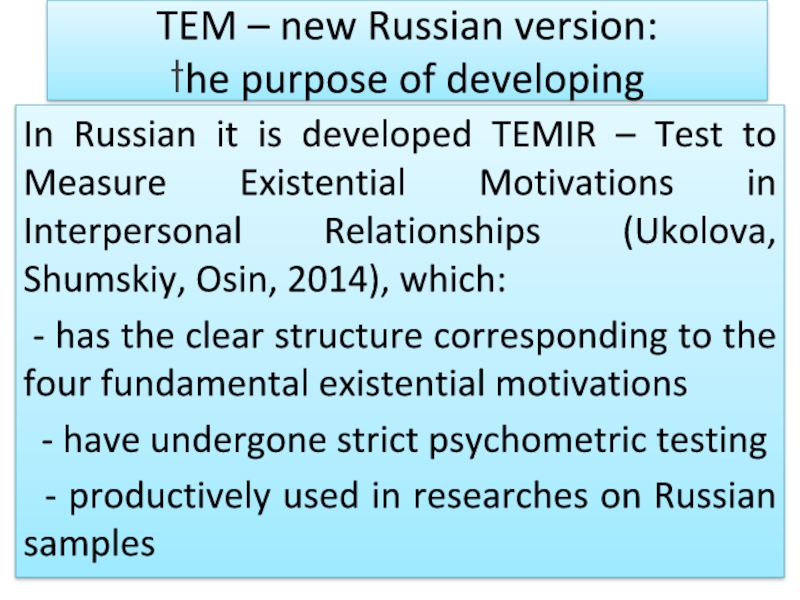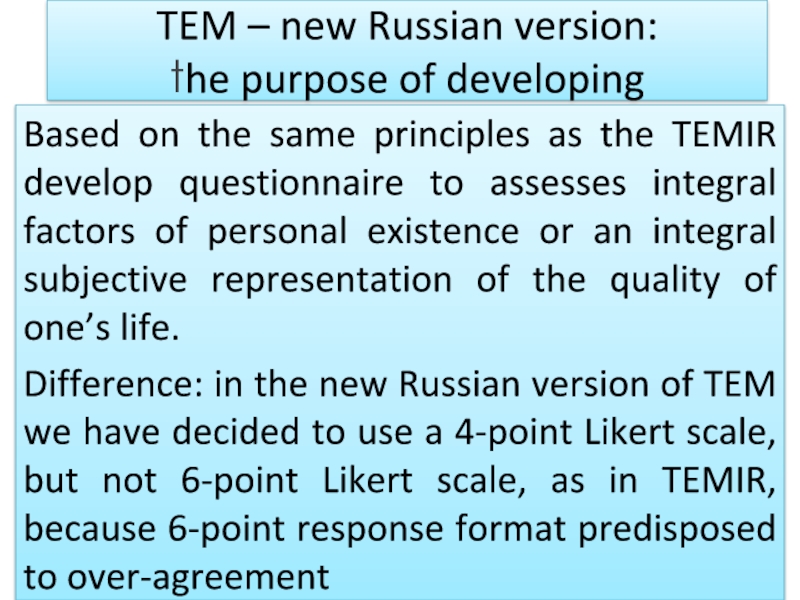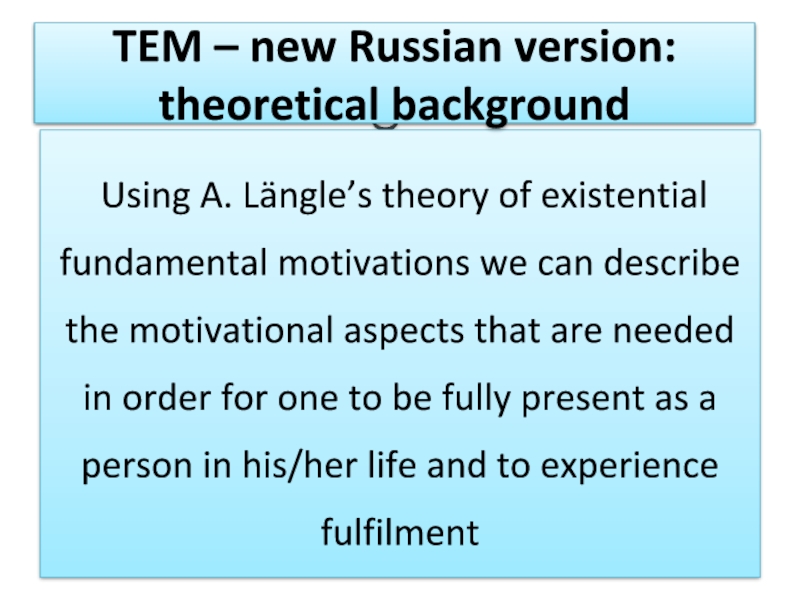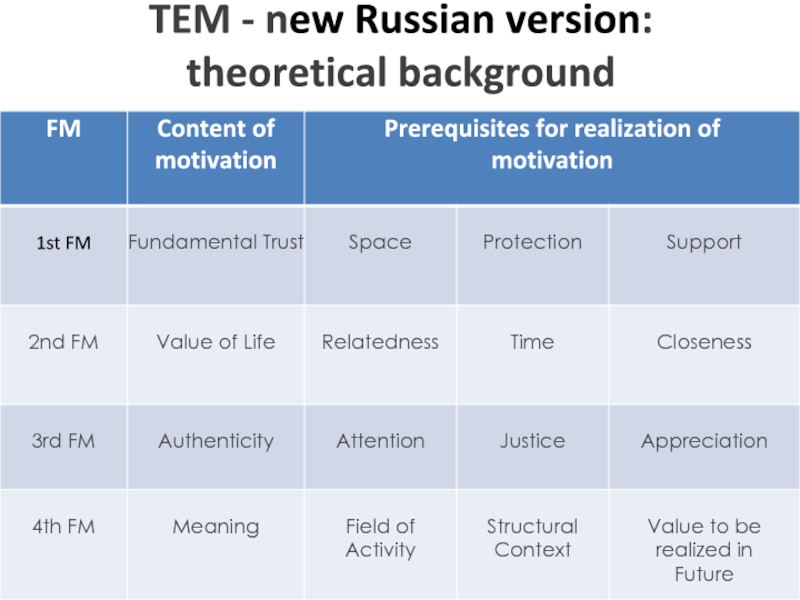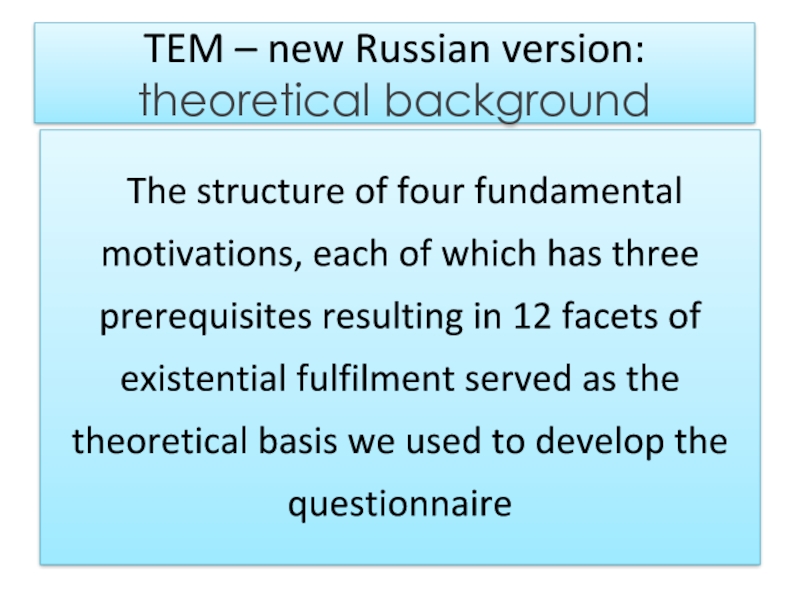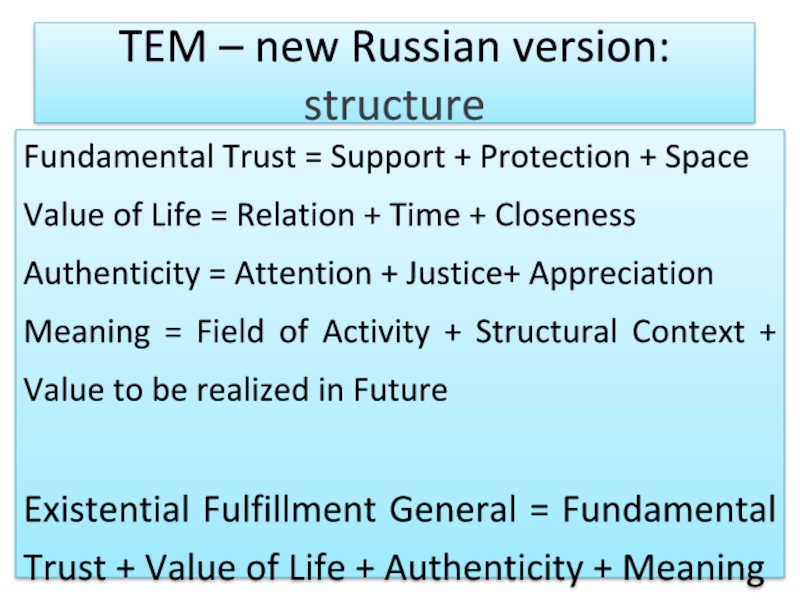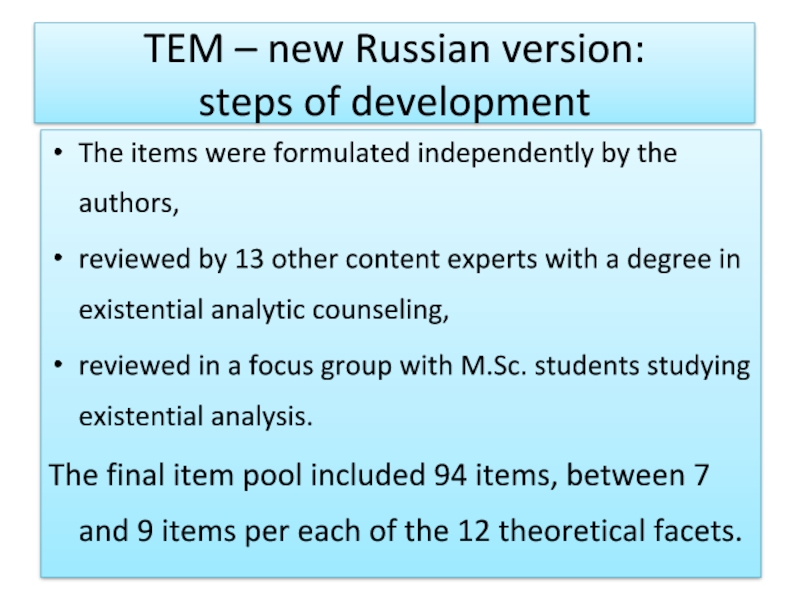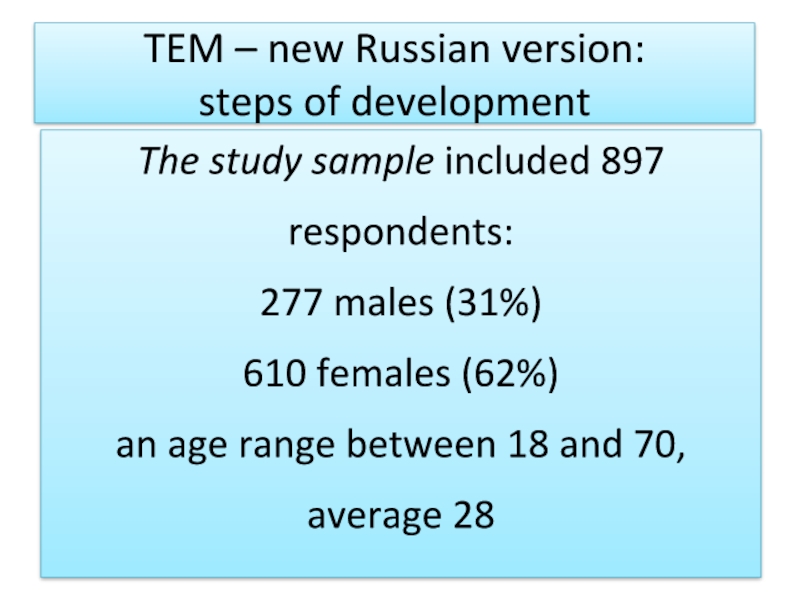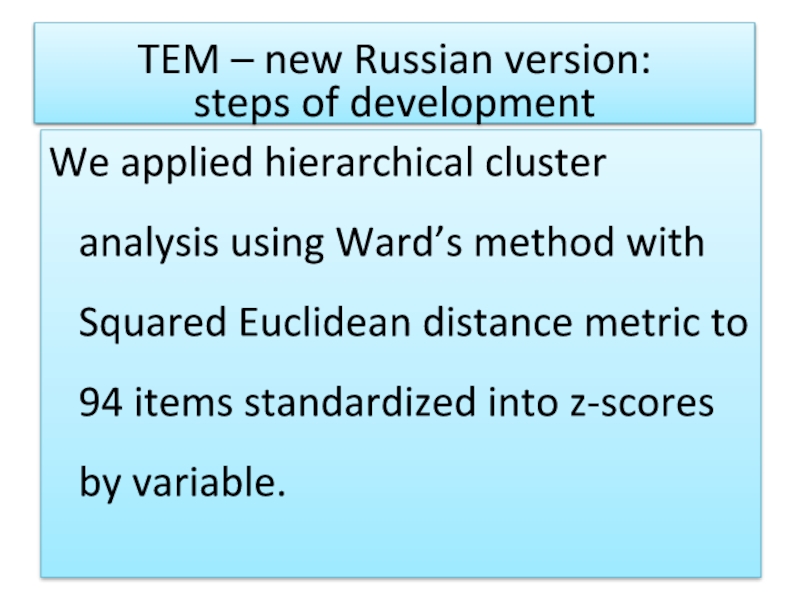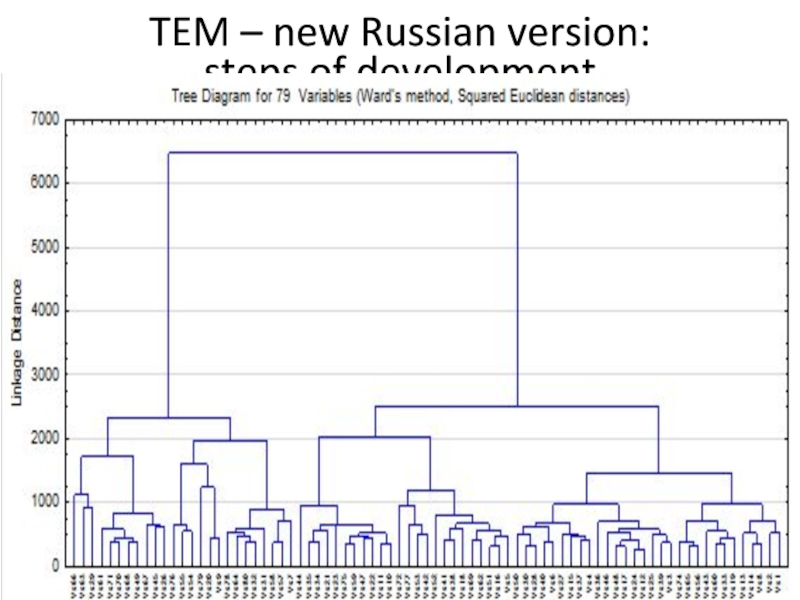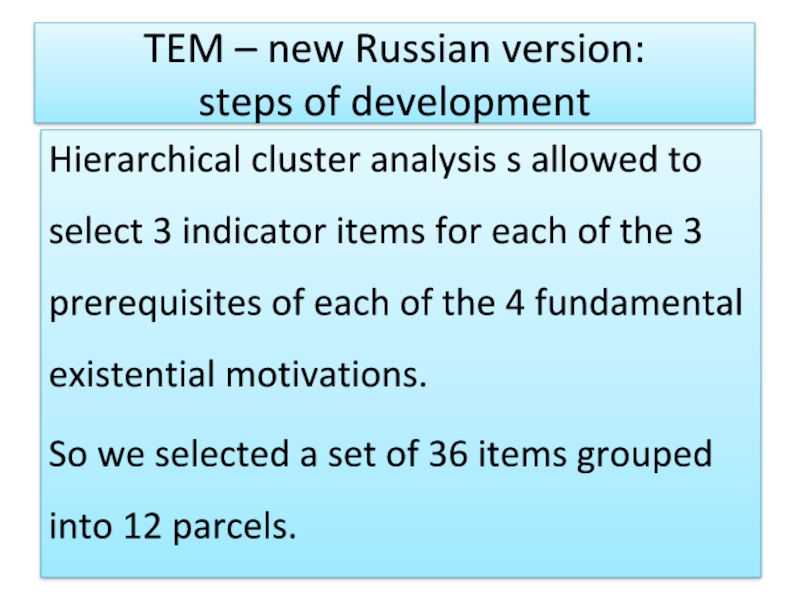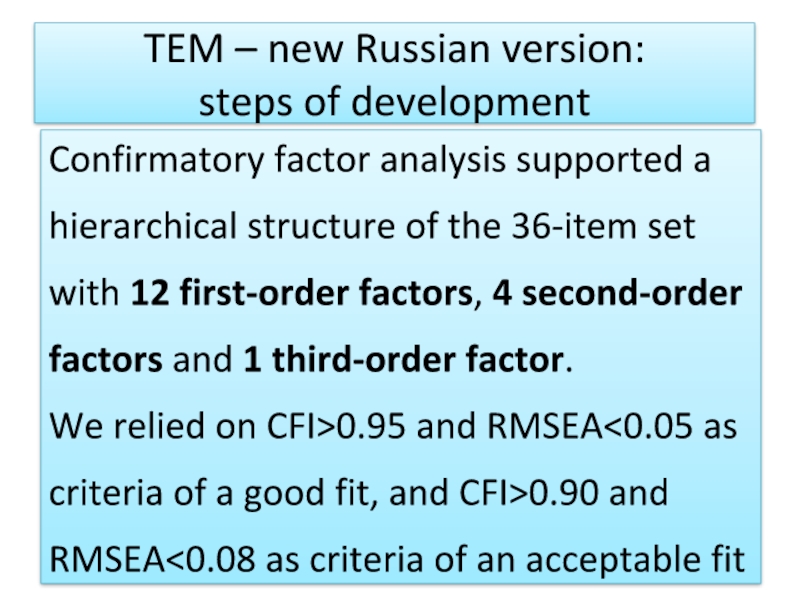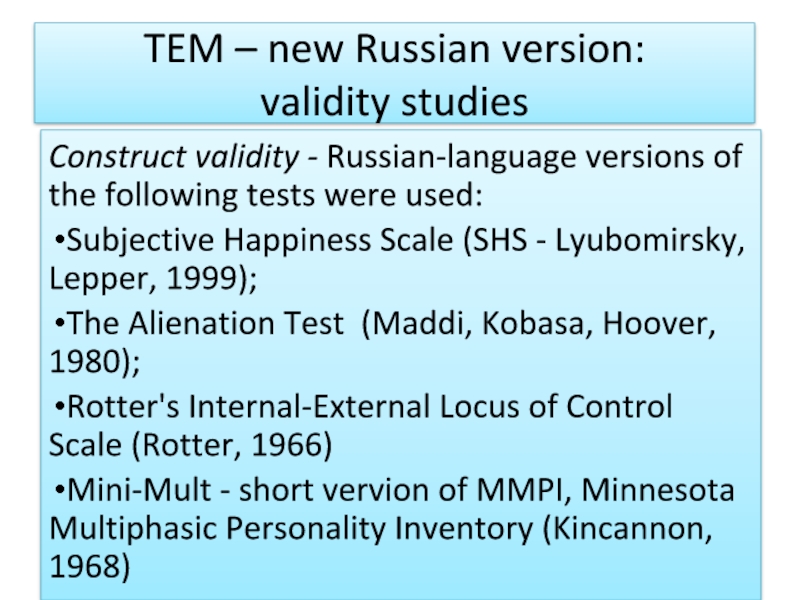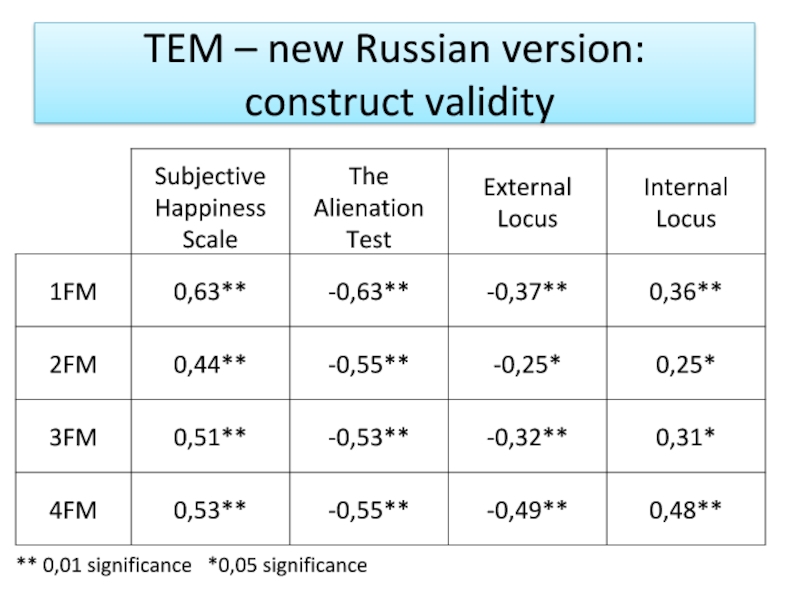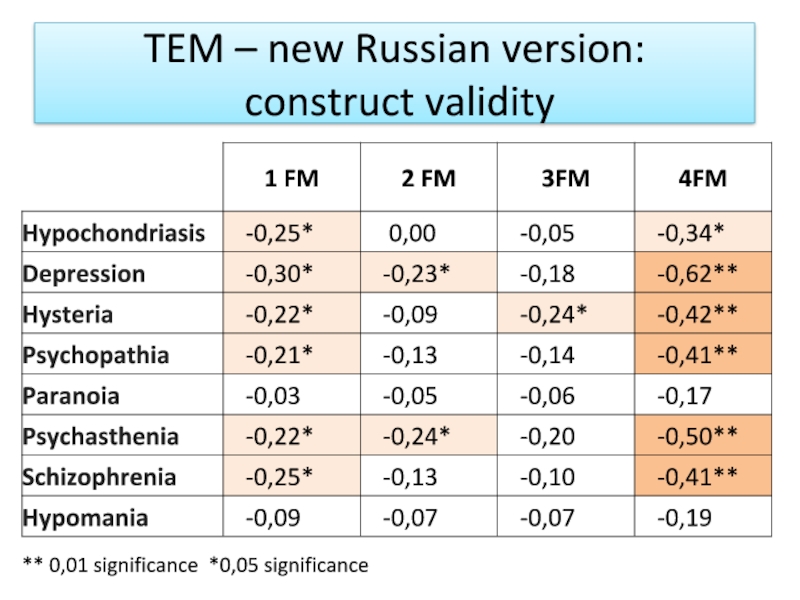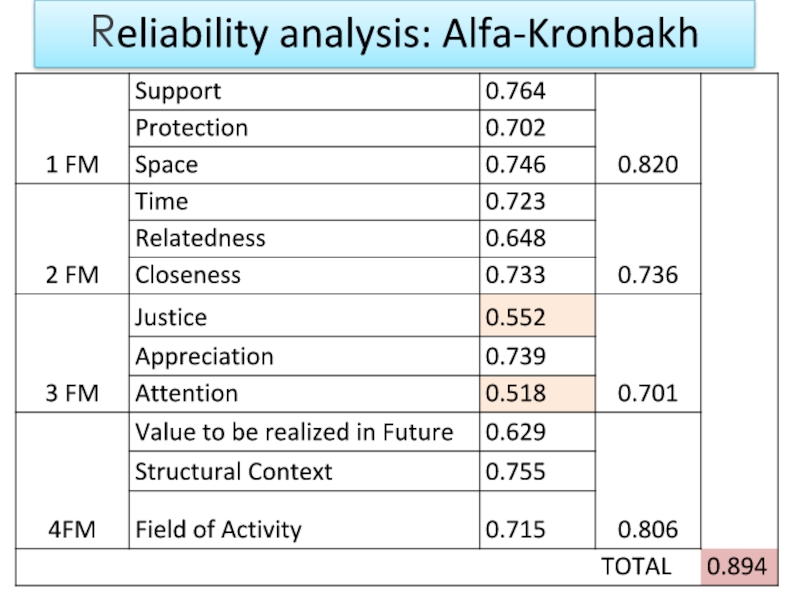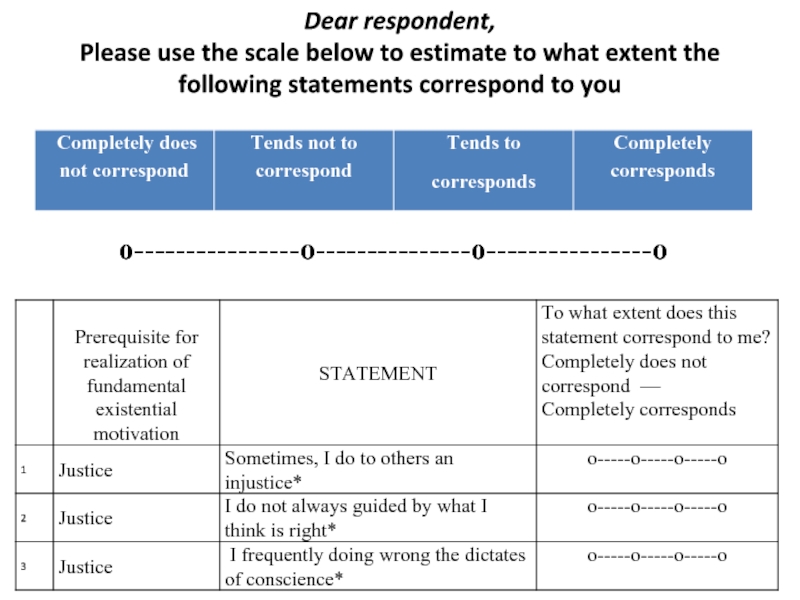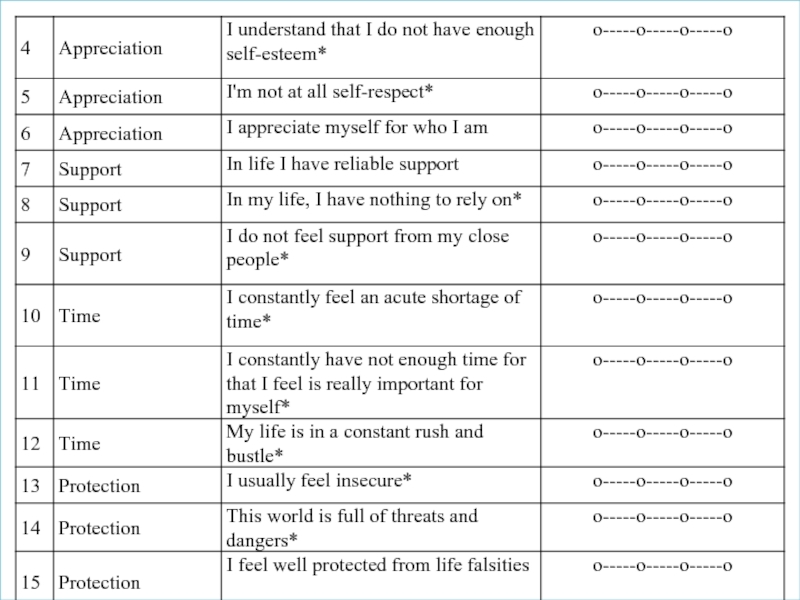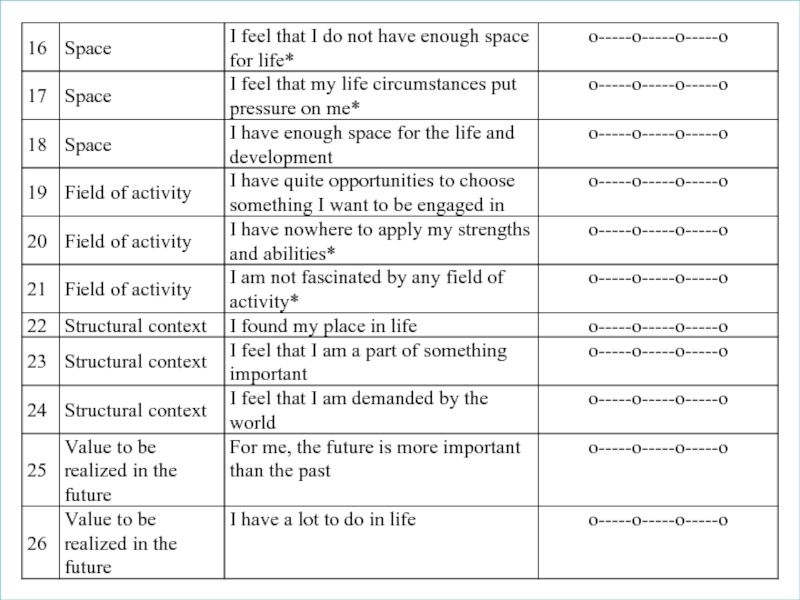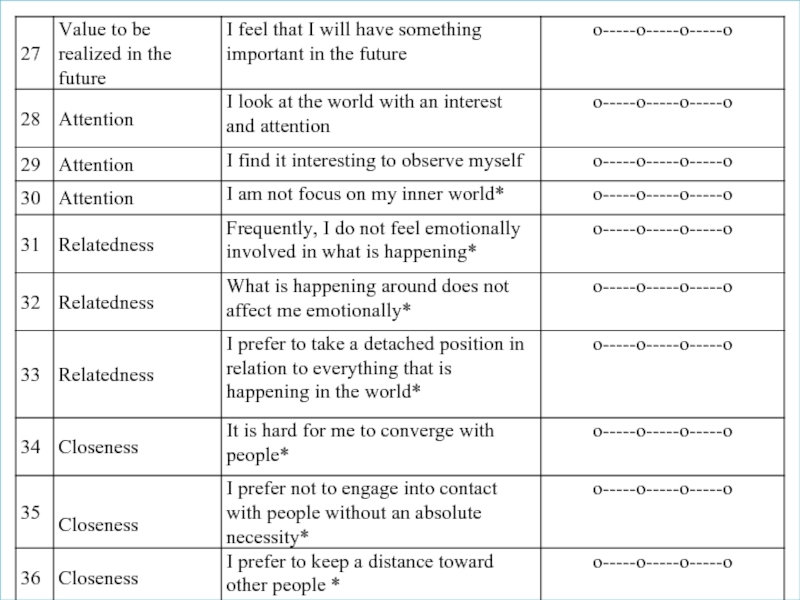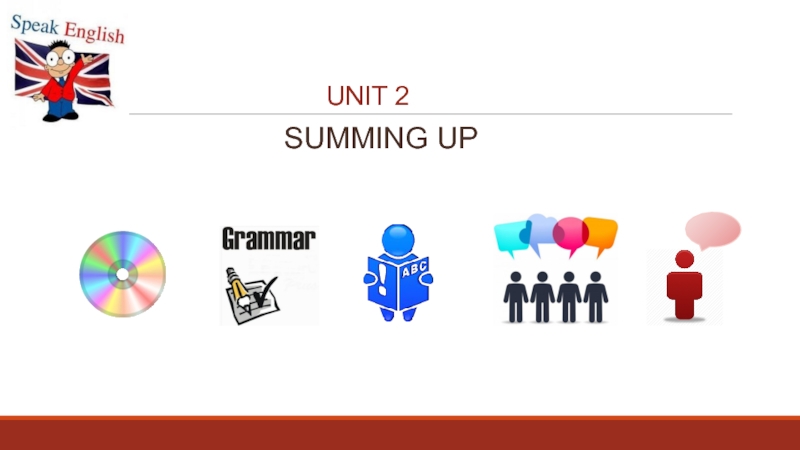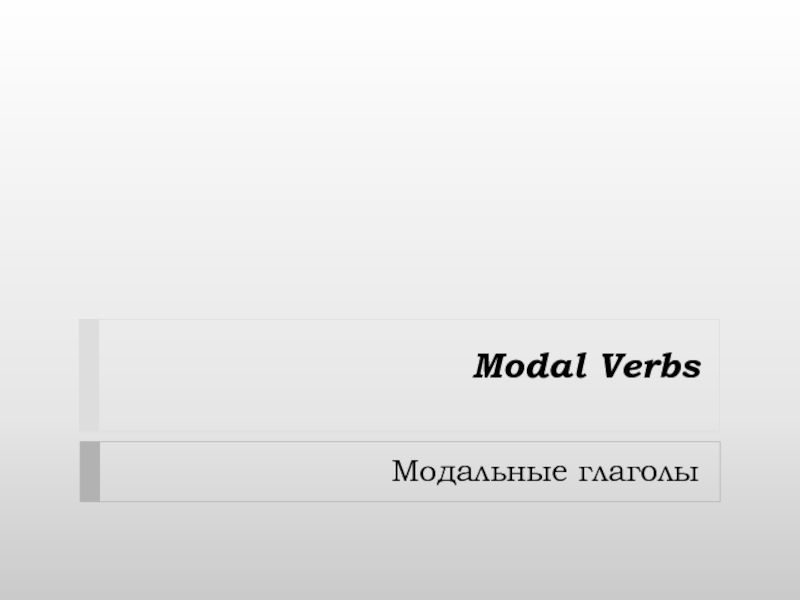New Russian Version of the
Test of Existential Motivations:
development and testing
- Главная
- Разное
- Дизайн
- Бизнес и предпринимательство
- Аналитика
- Образование
- Развлечения
- Красота и здоровье
- Финансы
- Государство
- Путешествия
- Спорт
- Недвижимость
- Армия
- Графика
- Культурология
- Еда и кулинария
- Лингвистика
- Английский язык
- Астрономия
- Алгебра
- Биология
- География
- Детские презентации
- Информатика
- История
- Литература
- Маркетинг
- Математика
- Медицина
- Менеджмент
- Музыка
- МХК
- Немецкий язык
- ОБЖ
- Обществознание
- Окружающий мир
- Педагогика
- Русский язык
- Технология
- Физика
- Философия
- Химия
- Шаблоны, картинки для презентаций
- Экология
- Экономика
- Юриспруденция
New russian version of the test of existential motivations. Development and testing презентация
Содержание
- 1. New russian version of the test of existential motivations. Development and testing
- 2. TEM – new Russian version: the
- 3. TEM – new Russian version: the
- 4. TEM – new Russian version: the
- 5. TEMIR:Theoretical background Using A. Längle’s
- 6. TEM - new Russian version: theoretical background
- 7. TEM – new Russian version: theoretical background
- 8. TEM – new Russian version: structure Fundamental
- 9. TEM – new Russian version: steps
- 10. TEM – new Russian version: steps
- 11. TEMIR: steps of development We applied hierarchical
- 12. TEM – new Russian version: steps of development
- 13. TEM – new Russian version: steps
- 14. TEM – new Russian version: steps
- 15. TEM – new Russian version: validity
- 16. TEM – new Russian version: construct validity
- 17. TEM – new Russian version: construct validity
- 18. Reliability analysis: Alfa-Kronbakh
- 19. Dear respondent, Please use the scale
- 23. Thank you for your attention!
Слайд 1
Elena Ukolova, Vladimir Shumskiy
National Research University “Higher School
of Economics”, Moscow
Слайд 2TEM – new Russian version:
the purpose of developing
First Russian-language version of TEM (Koryakina, 2010, 2011):
- haven't undergone strict psychometric testing (a validity, internal structure of the test)
- the contents of items are more focused on counseling and therapeutic practice, but not on researches in the general population
- some items of the test don't express specifics of the measured constructs (the contents of FM)
- items obtained by direct translation from the German version TEM v.2.1 and encountered significant language/wording problems in Russian
- haven't undergone strict psychometric testing (a validity, internal structure of the test)
- the contents of items are more focused on counseling and therapeutic practice, but not on researches in the general population
- some items of the test don't express specifics of the measured constructs (the contents of FM)
- items obtained by direct translation from the German version TEM v.2.1 and encountered significant language/wording problems in Russian
Слайд 3TEM – new Russian version:
the purpose of developing
In Russian it
is developed TEMIR – Test to Measure Existential Motivations in Interpersonal Relationships (Ukolova, Shumskiy, Osin, 2014), which:
- has the clear structure corresponding to the four fundamental existential motivations
- have undergone strict psychometric testing
- productively used in researches on Russian samples
- has the clear structure corresponding to the four fundamental existential motivations
- have undergone strict psychometric testing
- productively used in researches on Russian samples
Слайд 4TEM – new Russian version:
the purpose of developing
Based on the
same principles as the TEMIR develop questionnaire to assesses integral factors of personal existence or an integral subjective representation of the quality of one’s life.
Difference: in the new Russian version of TEM we have decided to use a 4-point Likert scale, but not 6-point Likert scale, as in TEMIR, because 6-point response format predisposed to over-agreement
Difference: in the new Russian version of TEM we have decided to use a 4-point Likert scale, but not 6-point Likert scale, as in TEMIR, because 6-point response format predisposed to over-agreement
Слайд 5TEMIR:Theoretical background
Using A. Längle’s theory of existential fundamental motivations we
can describe the motivational aspects that are needed in order for one to be fully present as a person in his/her life and to experience fulfilment
TEM – new Russian version: theoretical background
Слайд 7TEM – new Russian version: theoretical background
The structure of four
fundamental motivations, each of which has three prerequisites resulting in 12 facets of existential fulfilment served as the theoretical basis we used to develop the questionnaire
Слайд 8TEM – new Russian version: structure
Fundamental Trust = Support + Protection
+ Space
Value of Life = Relation + Time + Closeness
Authenticity = Attention + Justice+ Appreciation
Meaning = Field of Activity + Structural Context + Value to be realized in Future
Existential Fulfillment General = Fundamental Trust + Value of Life + Authenticity + Meaning
Value of Life = Relation + Time + Closeness
Authenticity = Attention + Justice+ Appreciation
Meaning = Field of Activity + Structural Context + Value to be realized in Future
Existential Fulfillment General = Fundamental Trust + Value of Life + Authenticity + Meaning
Слайд 9TEM – new Russian version:
steps of development
The items were formulated
independently by the authors,
reviewed by 13 other content experts with a degree in existential analytic counseling,
reviewed in a focus group with M.Sc. students studying existential analysis.
The final item pool included 94 items, between 7 and 9 items per each of the 12 theoretical facets.
reviewed by 13 other content experts with a degree in existential analytic counseling,
reviewed in a focus group with M.Sc. students studying existential analysis.
The final item pool included 94 items, between 7 and 9 items per each of the 12 theoretical facets.
Слайд 10TEM – new Russian version:
steps of development
The study sample included
897 respondents:
277 males (31%)
610 females (62%)
an age range between 18 and 70,
average 28
277 males (31%)
610 females (62%)
an age range between 18 and 70,
average 28
Слайд 11TEMIR: steps of development
We applied hierarchical cluster analysis using Ward’s method
with Squared Euclidean distance metric to 94 items standardized into z-scores by variable.
TEM – new Russian version:
steps of development
Слайд 13TEM – new Russian version:
steps of development
Hierarchical cluster analysis s
allowed to select 3 indicator items for each of the 3 prerequisites of each of the 4 fundamental existential motivations.
So we selected a set of 36 items grouped into 12 parcels.
So we selected a set of 36 items grouped into 12 parcels.
Слайд 14TEM – new Russian version:
steps of development
Confirmatory factor analysis supported
a hierarchical structure of the 36-item set with 12 first-order factors, 4 second-order factors and 1 third-order factor.
We relied on CFI>0.95 and RMSEA<0.05 as criteria of a good fit, and CFI>0.90 and RMSEA<0.08 as criteria of an acceptable fit of the model to the data.
We relied on CFI>0.95 and RMSEA<0.05 as criteria of a good fit, and CFI>0.90 and RMSEA<0.08 as criteria of an acceptable fit of the model to the data.
Слайд 15TEM – new Russian version:
validity studies
Construct validity - Russian-language versions
of the following tests were used:
Subjective Happiness Scale (SHS - Lyubomirsky, Lepper, 1999);
The Alienation Test (Maddi, Kobasa, Hoover, 1980);
Rotter's Internal-External Locus of Control Scale (Rotter, 1966)
Mini-Mult - short vervion of MMPI, Minnesota Multiphasic Personality Inventory (Kincannon, 1968)
Subjective Happiness Scale (SHS - Lyubomirsky, Lepper, 1999);
The Alienation Test (Maddi, Kobasa, Hoover, 1980);
Rotter's Internal-External Locus of Control Scale (Rotter, 1966)
Mini-Mult - short vervion of MMPI, Minnesota Multiphasic Personality Inventory (Kincannon, 1968)
Слайд 19Dear respondent, Please use the scale below to estimate to what
extent the following statements correspond to you
o----------------o---------------o----------------o
